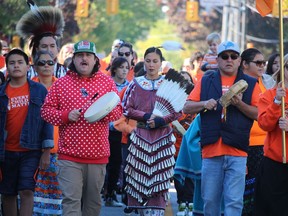Hundreds march as National Day for Truth and Reconciliation observed in Sarnia
Residential school survivor Pauline Williams pointed to her youngest grandson in the crowd Friday at Sarnia’s National Day of Truth and Reconciliation gathering and said he “will never have to go and stay there.”

Article content
Residential school survivor Pauline Williams pointed to her youngest grandson in the crowd Friday at Sarnia’s National Day for Truth and Reconciliation gathering and said he “will never have to go and stay there.”
Williams, one of the speakers at Sarnia City Hall during the event organized by the Sarnia-Lambton Native Friendship Centre, said she was only six years old when she first went to a Roman Catholic all-girls residential school in Spanish, Ont., seven decades ago.
“Using my language was the worst thing I got punished for,” she said.

She was given a number when she arrived at the school.
“I was 136 for nine years” until the school closed, Williams said.
“I didn’t know any English at all when I went there,” she said. “They keep talking to you in English, and they knew you don’t understand it.
“I could say ‘yes’ and ‘no’ but I didn’t know which was which.”
Williams said learned “quite a bit” of English by the end of her first year at the school and eventually it was all she spoke when she was back at home, although she was still able to speak her own language when she later moved to Sarnia.
“They were starting to lose the language then when I came here a little over 50 years ago,” she said. “I’m really glad that the children at school are starting to pick up the language.”
She said she worried while raising her own children they might be taken away to residential schools.
“I still thought maybe it could possibly happen,” Williams said, “but it’s not going to happen, right?”
Canada’s first National Day for Truth and Reconciliation was held in 2021 to recognize the tragic legacy of residential schools, the missing children, families left behind and survivors.
It was established in response to one of the recommendations made by Canada’s Truth and Reconciliation Commission.

It was the policy of Canada’s federal government for more than 100 years to separate Indigenous children from their families and send them to residential schools, often run by churches and religious organizations, as a means of cultural genocide.
The children were often poorly housed and poorly fed, and many were physically and sexually abused.
The 2015 final report of the Truth and Reconciliation Commission of Canada stated that “many, if not most, of the several thousand children who died in residential schools are likely to be buried in unmarked and untended graves.”
The Sept. 30 federal holiday coincides with Orange Shirt Day, a national initiative by residential school survivor Phyllis Webstad to commemorate the residential school experience, honour survivors and their families, and commit to the ongoing process of reconciliation, according to the organization’s website.

Like the Peace Tower on Parliament Hill in Ottawa, Sarnia’s City Hall was to be illuminated Friday evening in orange light.
Friday’s observance in Sarnia included a flag-raising at the St. Clair Riverfront and then a march by several hundred people from Veteran’s Park through downtown to city hall, where Williams and others spoke.
“We dance, sing and pray today for the families who waited for their children to return home,” said Nancy Roy with the Friendship Centre.
Later in the morning, a short ceremony was held at the corner of Lochiel and Front streets where the city’s second orange memorial crosswalk recognizing victims of residential schools was installed.
The first was dedicated in June at the corner of Christina Street and Cathcart Boulevard.
“We encourage everyone to reflect and recognize the ongoing effects of intergenerational trauma impacting survivors, their families and their communities,” said Candace Young, chairperson of the city’s UN Declaration on the Rights of Indigenous Peoples committee.
Postmedia is committed to maintaining a lively but civil forum for discussion. Please keep comments relevant and respectful. Comments may take up to an hour to appear on the site. You will receive an email if there is a reply to your comment, an update to a thread you follow or if a user you follow comments. Visit our Community Guidelines for more information.